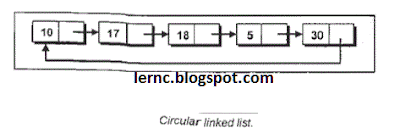
The linked lisis that we have seen so far are often known as linear linked lists. The elements of such a linked list can be accessed, first by setting up a pointer pointing to the first node in the list and then traversing the entire list using this pointer. Although a linear linked list is a useful data structure, it has several shortcomings. For example, given a pointer p to a node in a linear list, we cannot reach any of the nodes that precede the node to which p is pointing. This disadvantage can be overcome by making a small change to the structure of a linear list such that the link field in the last node contains a pointer back to the first node rather than a NULL. Such a list is called a circular linked list.
Related Links :
History Of C..
In the beginning was Charles Babbage and his Analytical Engine, a machine
he built in 1822 that could be programmed to carry out different computations.
Move forward more than 100 years, where the U.S. government in
1942 used concepts from Babbage’s engine to create the ENIAC, the first
modern computer.
Meanwhile, over at the AT&T Bell Labs, in 1972 Dennis Ritchie was working
with two languages: B (for Bell) and BCPL (Basic Combined Programming
Language). Inspired by Pascal, Mr. Ritchie developed the C programming
language.
My 1st Program...
#include
#include
void main ()
{
clrscr ();
printf ("\n\n\n\n");
printf ("\t\t\t*******Pankaj *******\n");
printf ("\t\t\t********************************\n");
printf ("\t\t\t\"Life is Good...\"\n");
printf ("\t\t\t********************************");
getch ();
}
Next Step...
#include
#include
void main ()
{
clrscr ();
printf ("\n\n\n\n\n\n\n\n");
printf ("\t\t\t --------------------------- \n\n");
printf ("\t\t\t | IGCT, Info Computers, INDIA | \n\n");
printf ("\t\t\t --------------------------- ");
getch ();
}








No comments:
Post a Comment